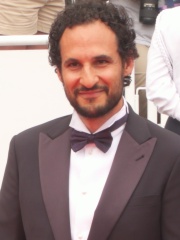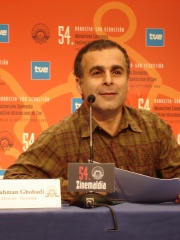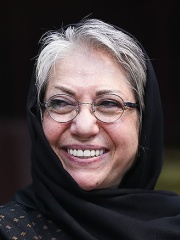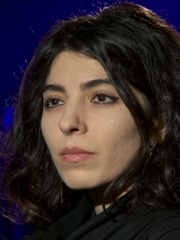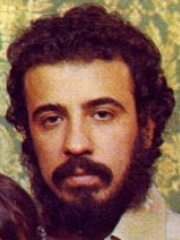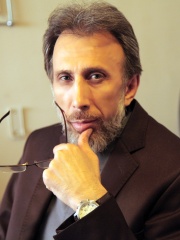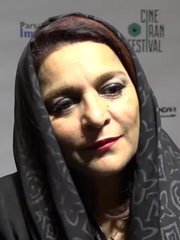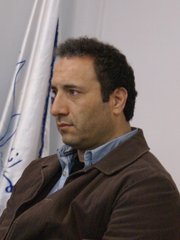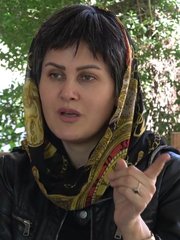
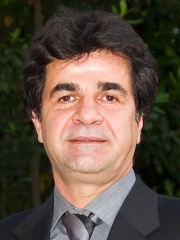
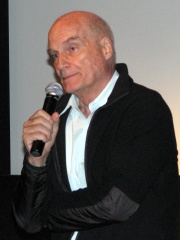
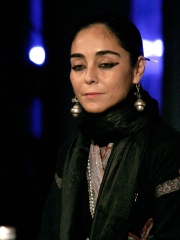
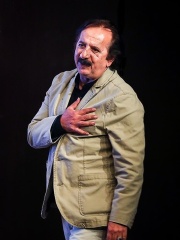
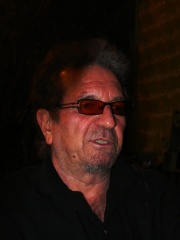
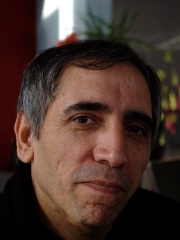
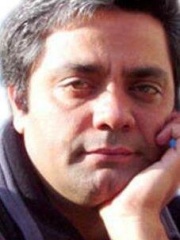
The Most Famous
FILM DIRECTORS from Iran
This page contains a list of the greatest Iranian Film Directors. The pantheon dataset contains 2,041 Film Directors, 22 of which were born in Iran. This makes Iran the birth place of the 20th most number of Film Directors behind Denmark, and Austria.
Top 10
The following people are considered by Pantheon to be the top 10 most legendary Iranian Film Directors of all time. This list of famous Iranian Film Directors is sorted by HPI (Historical Popularity Index), a metric that aggregates information on a biography's online popularity. Visit the rankings page to view the entire list of Iranian Film Directors.

1. Abbas Kiarostami (1940 - 2016)
With an HPI of 72.89, Abbas Kiarostami is the most famous Iranian Film Director. His biography has been translated into 63 different languages on wikipedia.
Abbas Kiarostami (Persian: عباس کیارستمی [ʔæbˌbɒːs kijɒːɾostæˈmi] ; 22 June 1940 – 4 July 2016) was an Iranian film director, screenwriter, poet, photographer, and film producer. An active filmmaker from 1970, Kiarostami had been involved in the production of over forty films, including shorts and documentaries. Kiarostami attained critical acclaim for directing the Koker trilogy (1987–1994), Close-Up (1990), The Wind Will Carry Us (1999), and Taste of Cherry (1997), which was awarded the Palme d'Or at the Cannes Film Festival that year. In later works, Certified Copy (2010) and Like Someone in Love (2012), he filmed for the first time outside Iran: in Italy and Japan, respectively. His films Where Is the Friend's House? (1987), Close-Up, and The Wind Will Carry Us were ranked among the 100 best foreign films in a 2018 critics' poll by BBC Culture. Close-Up was also ranked one of the 50 greatest movies of all time in the famous decennial Sight & Sound poll conducted in 2012. Kiarostami had worked extensively as a screenwriter, film editor, art director, and producer and had designed credit titles and publicity material. He was also a poet, photographer, painter, illustrator, and graphic designer. He was part of a generation of filmmakers in the Iranian New Wave, a Persian cinema movement that started in the late 1960s and emphasized the use of poetic dialogue and allegorical storytelling dealing with political and philosophical issues. Kiarostami had a reputation for using child protagonists, for documentary-style narrative films, for stories that take place in rural villages, and for conversations that unfold inside cars, using stationary mounted cameras. He is also known for his use of Persian poetry in the dialogue, titles, and themes of his films. Kiarostami's films contain a notable degree of ambiguity, an unusual mixture of simplicity and complexity, and often a mix of fictional and documentary elements. The concepts of change and continuity, in addition to the themes of life and death, play a major role in Kiarostami's works.

2. Jafar Panahi (b. 1960)
With an HPI of 67.72, Jafar Panahi is the 2nd most famous Iranian Film Director. His biography has been translated into 50 different languages.
Jafar Panâhi (Persian: جعفر پناهی, [d͡ʒæˈfæɾ pænɒːˈhiː]) (born 11 July 1960) is an Iranian filmmaker and actor. He is known internationally for his artistically significant contributions to post-1979 Revolution Iranian cinema and has been associated with the Iranian New Wave. His work, deeply rooted in neorealism and centered on the lives of women, children, and the marginalized, constitutes a powerful critical portrait of the social, political, and gender structures of contemporary Iran. Panahi began his career making short films and working as an assistant to Abbas Kiarostami. His debut feature, The White Balloon (1995), won the Caméra d'Or at the 1995 Cannes Film Festival, marking the first major award for an Iranian film at that event. Panahi is one of only four directors in history—alongside Henri-Georges Clouzot, Michelangelo Antonioni and Robert Altman—to win the top prizes at Europe's three major film festivals: the Palme d'Or at Cannes, the Golden Bear at Berlin, and the Golden Lion at Venice, awarded respectively for It Was Just an Accident (2025), Taxi (2015), and The Circle (2000). Among numerous accolades, he is the recipient of Telluride Film Festival Silver Medallion and two nominations of Golden Globe Awards, the first Iranian filmmaker to receive major recognition. Panahi's career has been inextricably marked by conflict with Iranian authorities. Starting with his third feature film, The Circle (2000), which addresses the situation of women in Iran, his films have frequently been banned or censored in the country. In 2010, the filmmaker was sentenced to six years in prison and a 20-year ban on filmmaking activities, based on charges of "propaganda against the Islamic Republic." Even under legal restrictions, Panahi continued to make films without permission, many of them produced semi-clandestinely. This Is Not a Film (2011), Closed Curtain (2013), Taxi (2015), and No Bears (2022) are works that often reflect, in a metacinematic way, on his own limitations as an artist under state surveillance. His legal confrontations remain ongoing, with new sentences such as the in absentia prison term decreed in 2025. In addition to his filmmaking, Panahi was awarded the Sakharov Prize for Freedom of Thought by the European Parliament in 2012, in recognition of his defense of freedom of expression.

3. Barbet Schroeder (b. 1941)
With an HPI of 64.03, Barbet Schroeder is the 3rd most famous Iranian Film Director. His biography has been translated into 29 different languages.
Barbet Schroeder (born 26 August 1941) is an Iranian-born Swiss film director and producer who started his career in French cinema in the 1960s, working with directors of the French New Wave such as Jean-Luc Godard, Jacques Rivette and Eric Rohmer. Schroeder started his career producing such films as The Bakery Girl of Monceau (1962), Six in Paris (1965), and Celine and Julie Go Boating (1974). He then transitioned into directing films such as More (1969), La Vallée (1972) and Barfly (1987), the last of which was nominated for the Palme d'Or. He also gained recognition for directing the documentary Koko: A Talking Gorilla (1978). He directed what he labeled, "The Trilogy of Evil", which includes the films, General Idi Amin Dada: A Self Portrait (1974), Terror's Advocate (2007) and The Venerable W. (2016). He directed the drama Reversal of Fortune (1990) and earned a nomination for Academy Award for Best Director. He then directed many big budget Hollywood films, often mixing melodrama with the thriller genre in films like Single White Female (1992), Kiss of Death (1995), Desperate Measures (1998) and Murder by Numbers (2002). He also acted in Beverly Hills Cop III (1994), Mars Attacks! (1996) and The Darjeeling Limited (2007).

4. Shirin Neshat (b. 1957)
With an HPI of 61.18, Shirin Neshat is the 4th most famous Iranian Film Director. Her biography has been translated into 35 different languages.
Shirin Neshat (Persian: شیرین نشاط; born March 26, 1957) is an Iranian photographer and visual artist who lives in New York City, known primarily for her work in film, video and photography. Her artwork centers on the contrasts between Islam and the West, femininity and masculinity, public life and private life, antiquity and modernity, and bridging the spaces between these subjects. Since the Islamic Revolution, she has said that she has "gravitated toward making art that is concerned with tyranny, dictatorship, oppression and political injustice. Although I don’t consider myself an activist, I believe my art – regardless of its nature – is an expression of protest, a cry for humanity.” Neshat has been recognized for winning the International Award of the XLVIII Venice Biennale in 1999, and the Silver Lion as the best director at the 66th Venice Film Festival in 2009, to being named Artist of the Decade by HuffPost critic G. Roger Denson. Neshat was a visiting critic in the photography department at the Yale School of Art in 2020.
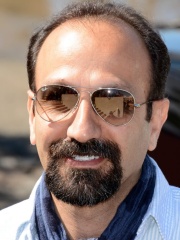
5. Asghar Farhadi (b. 1972)
With an HPI of 60.48, Asghar Farhadi is the 5th most famous Iranian Film Director. His biography has been translated into 54 different languages.
Asghar Farhadi (Persian: اصغر فرهادی [æsˈɢæɾ ɛ fæɾhɑːˈdiː] ; born 7 May 1972) is an Iranian film director and screenwriter. He is considered one of the most prominent filmmakers of Iranian cinema as well as world cinema in the 21st century. His films have gained recognition for their focus on the human condition, and portrayals of intimate and challenging stories of internal family conflicts. In 2012, he was included on the annual Time 100 list of the most influential people in the world. That same year, he also received the Legion of Honour from France. Farhadi made his directorial film debut with the drama Dancing in the Dust (2003), followed by The Beautiful City (2004) and Fireworks Wednesday (2006). He gained acclaim for his film About Elly (2009) earning a Silver Bear for Best Director. He became one of the few directors worldwide to have won the Academy Award for Best International Feature Film twice, for the family drama A Separation (2011) and the moral drama The Salesman (2016), the latter of which also received the Cannes Film Festival Award for Best Screenplay. He also earned acclaim for his films The Past (2013), which was filmed in France, and Everybody Knows (2018), which was filmed in Spain. Farhadi returned to Iran with A Hero (2021), which earned him the Cannes Film Festival's Grand Prix.

6. Majid Majidi (b. 1959)
With an HPI of 59.62, Majid Majidi is the 6th most famous Iranian Film Director. His biography has been translated into 38 different languages.
Majid Majidi (Persian: مجید مجیدی, romanized: Majīd Majīdī) is an Iranian filmmaker and producer. In his films, Majidi has touched on many themes and genres and has won numerous international awards.

7. Dariush Mehrjui (1939 - 2023)
With an HPI of 58.75, Dariush Mehrjui is the 7th most famous Iranian Film Director. His biography has been translated into 28 different languages.
Dariush Mehrjui (Persian: داریوش مهرجویی; 8 December 1939 – 14 October 2023) was an Iranian filmmaker, screenwriter, and a member of the Iranian Academy of the Arts. Mehrjui was a founding member of the Iranian New Wave movement of the early 1970s, which also included directors Masoud Kimiai and Nasser Taqvai. His second film, The Cow (1969), is considered to be the first film of this movement. Most of his films are inspired by literature and adapted from Iranian and foreign novels and plays. On 14 October 2023, Mehrjui and his wife, Vahideh Mohammadifar, were found stabbed to death in their home in the city of Karaj, near Tehran.

8. Mohsen Makhmalbaf (b. 1957)
With an HPI of 58.67, Mohsen Makhmalbaf is the 8th most famous Iranian Film Director. His biography has been translated into 31 different languages.
Mohsen Makhmalbaf (Persian: محسن مخملباف, [mohˈsen mæxmɒːlˈbɒːf]) (born May 29, 1957) is an Iranian film director, writer, film editor, and producer. He has made more than 20 feature films, won 50 awards, and served as a juror in more than 15 major film festivals. His award-winning films include A Moment of Innocence (1996) and Kandahar. His latest documentary is The Gardener and latest feature The President. Makhmalbaf's films have been widely presented at international film festivals since the early 21st century. The director belongs to the new wave movement of Iranian cinema. Time selected Makhmalbaf's 2001 film Kandahar as one of the top 100 films of all time. In 2006, he was a member of the Jury at the Venice Film Festival. Makhmalbaf left Iran in 2005 shortly after the election of Mahmoud Ahmadinejad. He has lived in Paris since the events of the 2009 Iranian presidential election.

9. Mohammad Rasoulof (b. 1972)
With an HPI of 57.96, Mohammad Rasoulof is the 9th most famous Iranian Film Director. His biography has been translated into 24 different languages.
Mohammad Rasoulof (Persian: محمد رسولاف; born 16 November 1972) is an Iranian independent filmmaker who lives in exile in Europe. He is known for several award-winning films, including The Twilight (2002), Iron Island (2005), Goodbye (2011), Manuscripts Don't Burn (2013), A Man of Integrity (2017) and There Is No Evil (2020). For the latter, he won the Golden Bear at the 2020 Berlin Film Festival. In 2025, Rasoulof was named one of the 100 Most Influential People by Time. He has been arrested several times and had his passport confiscated, as the nature and content of his films has brought him into conflict with the Iranian Government. In May 2024, following the announcement that his film The Seed of the Sacred Fig was selected in the main competition at the 2024 Cannes Film Festival, Mohammad Rasoulof was sentenced by the Islamic Republic to 8 years in prison, whipping, and a fine. Rasoulof fled to a safe house in Germany after the sentencing.
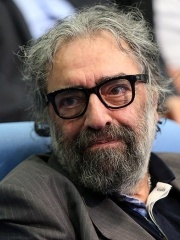
10. Masoud Kimiai (b. 1941)
With an HPI of 56.94, Masoud Kimiai is the 10th most famous Iranian Film Director. His biography has been translated into 19 different languages.
Masoud Kimiai or Masoud Kimiaei, (Persian: مسعود کیمیایی, [mæˈsuːd kimiːˈʔiː]; born 29 July 1941) is an Iranian director, screenwriter and producer.
People
Pantheon has 22 people classified as Iranian film directors born between 1939 and 1984. Of these 22, 18 (81.82%) of them are still alive today. The most famous living Iranian film directors include Jafar Panahi, Barbet Schroeder, and Shirin Neshat. The most famous deceased Iranian film directors include Abbas Kiarostami, Dariush Mehrjui, and Ali Hatami. As of April 2024, 5 new Iranian film directors have been added to Pantheon including Tahmineh Milani, Ebrahim Hatamikia, and Reza Mirkarimi.
Living Iranian Film Directors
Go to all RankingsJafar Panahi
1960 - Present
HPI: 67.72
Barbet Schroeder
1941 - Present
HPI: 64.03
Shirin Neshat
1957 - Present
HPI: 61.18
Asghar Farhadi
1972 - Present
HPI: 60.48
Majid Majidi
1959 - Present
HPI: 59.62
Mohsen Makhmalbaf
1957 - Present
HPI: 58.67
Mohammad Rasoulof
1972 - Present
HPI: 57.96
Masoud Kimiai
1941 - Present
HPI: 56.94
Ali Abbasi
1981 - Present
HPI: 54.75
Bahman Ghobadi
1969 - Present
HPI: 53.88
Rakhshān Banietemad
1954 - Present
HPI: 48.11
Samira Makhmalbaf
1980 - Present
HPI: 47.22
Deceased Iranian Film Directors
Go to all RankingsAbbas Kiarostami
1940 - 2016
HPI: 72.89
Dariush Mehrjui
1939 - 2023
HPI: 58.75
Ali Hatami
1944 - 1996
HPI: 53.97
Hossein Shahabi
1967 - 2023
HPI: 51.81
Newly Added Iranian Film Directors (2025)
Go to all RankingsTahmineh Milani
1960 - Present
HPI: 46.44
Ebrahim Hatamikia
1961 - Present
HPI: 46.39
Reza Mirkarimi
1967 - Present
HPI: 42.38
Behrouz Sebt Rasoul
1970 - Present
HPI: 40.97
Sahraa Karimi
1981 - Present
HPI: 40.46
Overlapping Lives
Which Film Directors were alive at the same time? This visualization shows the lifespans of the 4 most globally memorable Film Directors since 1700.

